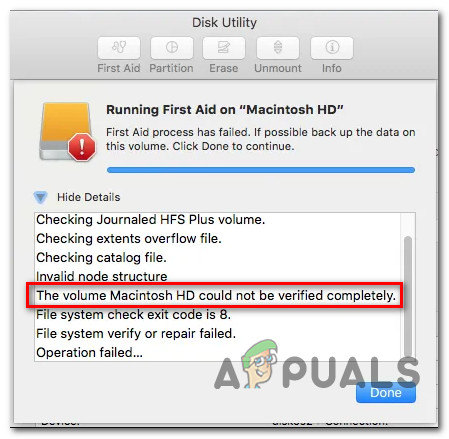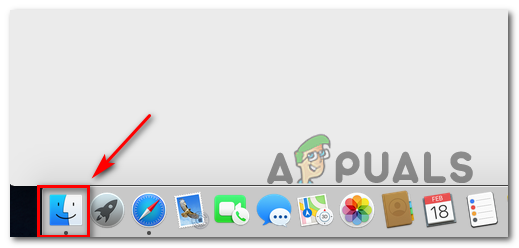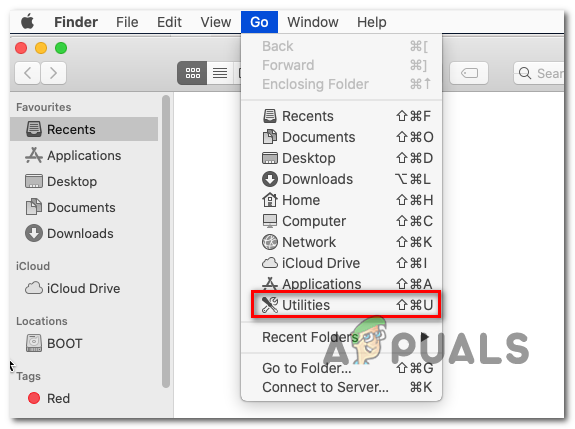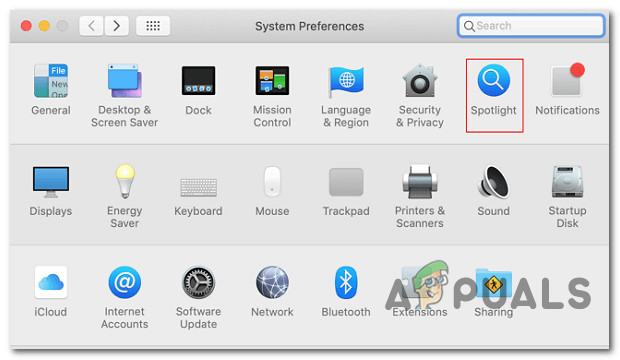[FIX] MAC Invalid Node Structure Error (Could Not Be Verified Completely)
Some users are reporting that running a First Aid scan on their Mac computer ends with the error Invalid node structure – The volume Macintosh HD could not be verified completely. This issue is reported to occur with a wide variety of different macOS versions.

After investigating this particular issue, it turns out that there are several different scenarios that might trigger this error code. Here’s a shortlist of culprits that might be responsible:
- A problem with the First Aid Utility interface – As it turns out, there’s a weird problem that seems to affect ElCapitan and High Sierra versions of macOS in which the First Aid utility acts up when forced to inspect a secondary drive. If this scenario is applicable, you should be able to fix this issue by trying to repair the disk via the Terminal app.
- Corrupted macOS files – As some affected users have been reported, you might expect to see this error due to some kind of corrupted OS files that end up affecting the First Aid utility. In this case, you can mount a previously created Machine Backup that’s either stored on a physical drive or on the crowd.
- Corrupted macOS startup sequence – If this is a debilitating issue that no longer allows your macOS computer to boot up, you should attempt to fix the corrupted booting sequence by using the Recovery Menu to reinstall all your macOS files.
- Failing disk drive – If you’re encountering this particular issue with a native OWC drive and none of the recovery options presented above prove to be effective, you should seriously consider investigating a hardware issue. If your Mac is still under warranty, send it in for a replacement. If it’s not, take it to a certified technician for investigations.
Now that you know every potential fix that might trigger this error code, here’s a list of methods that might allow you to fix this issue:
Method 1: Repairing the Disk via the Terminal App
If you’re encountering this issue while trying to run the First Aid utility on the affected drive, you should attempt to do the repairs via the Terminal app. Several affected users have confirmed that they’ve been able to fix the issue by opening the built-in Terminal app and running a command capable of repairing the drive remotely.
This particular issue is confirmed to work on a wide variety of macOS versions including ElCapitan, Sierra, High Sierra, and Mojave.
If you haven’t tried this type of fix yet, follow the instructions below:
- First things first, open the Finder app from the action bar at the bottom of the screen.

Accessing the Finder’s app - Once you’re inside the Finder’s app, click on the Go button (from the ribbon bar at the top), then click on the Utilities from the newly appeared context menu.

Accessing the utility menu - After you’re finally inside the Utilities screen, double-click on the Terminal app, then type the following command to trigger a standalone repair procedure:
sudo /sbin/fsck_hfs -yprd /dev/
Note: If the name of the affected disk in your case is different, you will need to replace disk0s2 with the name of the disk in your particular case.
- If you get the ‘Volume Macintosh HD could not be repaired after X attempts‘ you can repeat this procedure a couple of times and see if the problem is eventually resolved.
In case this workaround didn’t allow you to fix the issue in your particular case, move down to the next potential fix below.
Method 2: Using a Machine Backup
According to some affected Mac users, you might be able to reverse the corrupted files that are triggering the ‘Invalid node structure – The volume Macintosh HD could not be verified completely’ error by mounting a previously created machine backup in order to restore the Mac state back to a point where everything was functioning properly.
Of course, this will only work as long as the problem is not rooted in a hardware issue. The only requirement of this method is for you to have a previously created Time Machine backup (either on a physical disk or via the Time Capsule utility).
If you meet the requirements above, follow the instructions below to attempt to restore your macOS files back to a healthy state in which this First Aid utility error code was not occurring:
- Start by making sure that your backup disk is connected to your Mac.
Note: If you’re using Time Capsule, make sure that your home/work router is correctly set up and that your Mac connects to it. It should automatically ‘connect’ your backup disk to your Mac. - Next, use the Apple menu at the top to click on System Preferences from the context menu that just appeared.

Accessing the System Preferences tab - Once you’re inside the System Preferences menu, click on Spotlight from the list of available options.

Accessing the Spotlight utility - Next, from the Spotlight utility, open up the Migration Assistant and select the From a Mac, Time Machine backup, or startup disk toggle from the list of available options before clicking on Continue.

Using the Migration Assistant utility - Follow the remaining prompts to start the operation of restoring your macOS files from an existing backup, then wait for the operation to complete.
- Run another First Aid scan and see if the issue is now fixed.
In case the same Invalid node structure – The volume Macintosh HD could not be verified completely error is still interrupting the operation, move down to the next potential fix below.
Method 3: Boot in Recovery mode and Reinstall macOS
If none of the methods above, you have one more potential fix left before giving up and concluding that you’re dealing with a hardware issue is to boot up your Mac from Recovery mode and reinstalling macOS.
Of course, this is not ideal in situations where you have a lot of important data on your OS drive and you don’t have a backup in place. But it still beats not being able to boot up at all.
In case you find yourself in this particular scenario, follow the instructions below to force your Mac into Recovery mode and then use the macOS Utilities menu to Reinstall macOS. Several affected users have confirmed that this fix was the only thing that helped them fix the ‘Invalid node structure – The volume Macintosh HD could not be verified completely’ error.
Here’s a step-by-step guide that will walk you through the whole thing:
- If your macOS is on, turn it off or trigger a restart. While it boots up, hold Command + R until you see the Apple logo, then let both keys go.
- Once you’re inside the main macOS Utilities menu, choose Reinstall MacOS from the list of available options.

Reinstalling macOS - Next, follow the on-screen instructions to complete the process of reinstalling all your macOS files, then allow your computer to boot normally.
- After this process is complete, trigger another First Aid scan and see if you’re still seeing the same ‘Invalid node structure – The volume Macintosh HD could not be verified completely’ error.
In case the same kind of error is still popping up, you have no choice but to conclude that you’re actually dealing with a hardware issue.
Method 4: Take your Mac for Repairs (If applicable)
In case you’re seeing this error code with an OWC drive, I’m sorry to say this but, you’re most likely dealing with a hardware issue. Several affected users dealing with this same issue have confirmed that taking the HDD / SDD to a certified technician only meant the confirmation that the drive was irreparably busted.
If you find yourself in this particular scenario, you have 2 ways forward:
- If your Mac Computer is under warranty, contact Apple or the authorized reseller you made the initial purchase from to get a replacement.
- Get a replacement for your faulty OWC drive.
If you choose the second option, keep in mind that you should first go through some steps to ensure that you’re actually dealing with a faulty drive.





